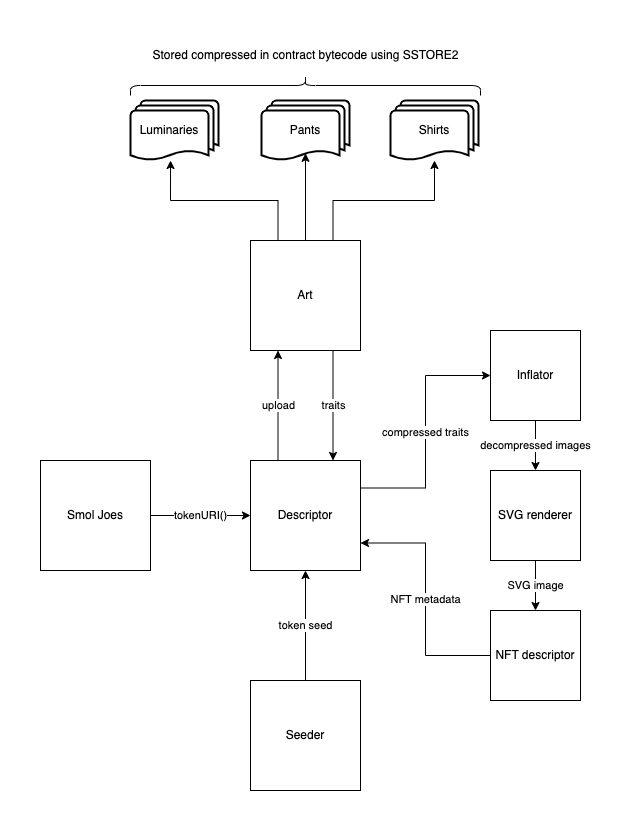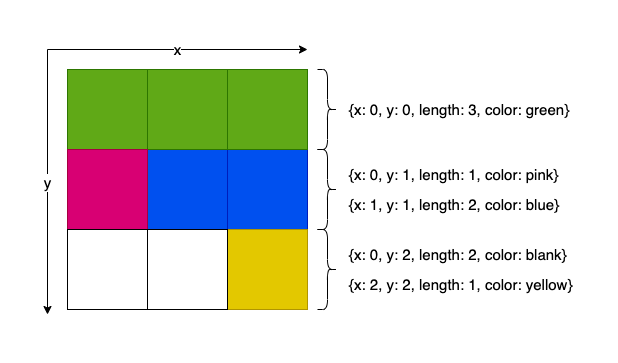Set of contracts used to upgrade, sell and generate metadata for the Smol Joes (The Expansion) NFT collection.
Main features:
- Fully on-chain metadata and image generation.
- Burn former Smol Joes and Smol Creeps NFTs to upgrade to the new collection.
- Burn NFT tokens sold on Launchpegs to mint randomly generated Smol Joes.
- Multichain support: buy and bridge the NFTs bewteen different chains.
Metadata and images for the Smol Joes collection are fully generated on chain, based on the method used by the Nouns NFT collection on Ethereum. This method allows to greatly compress the initial images to lower the cost of uploading them into the blockchain, using Run-length encoding (RLE). Note that this method is only suited for pixel art.
Instead of storing each pixel individually, which would take {x, y, color} = 5 bytes of data, each image is deconstructed in rectangles of the same color. Each rectangle being described by {x, y, length, color} = 6 bytes. If we take a 9x9 example (Smol Joes images are 45x45) :
Here, instead of storing 9 * 5 = 45 bytes of data, we do 5 * 6 = 30 bytes. This optimization is particularly suited for images that have large parts of the same color.
As a further optimization, colors, that take 3 bytes to be stored as RGB, are not stored in each individual rectangle, but instead in a color palette, i.e. a list of every color used. Each rectangle will now hold the color position in the palette, instead of the color itself. Since Smol Joes have more than 255 different colors, the index is stored in 2 bytes (instead of 3 for the full RGB).
Smol Joes images have been encoded using a script forked from the Nouns repository, that can be found here. After encoding, the bytes arrays are then compressed.
To reconstruct the final image, different contracts will be used, following this architecture:

Descriptor: This is the main point of entry. The Smol Joes contract will request the tokenURI from the descriptor.
Art: This contract will manage the uploaded images. Each group of images is called a page and will be stored in contract bytecode using Solady's SSTORE2. The contract is controlled by the Descriptor.
Seeder: This contract is responsible of randomly generating combinations of the uploaded art when a new token is minted.
Inflator: This contract decompress the data stored in the pages.
SVG Renderer: This contract will take every part of the token seed and convert the corresponding RLE encoded images into SVG rectangles.
NFT Descriptor: This contract will take the SVG image, encode it into a base64 string, add the rest of the metadata and then encode again to base64. This is what will be returned by tokenURI().
There is three different types of Smol Joes that can be built:
- Originals: Ugraded Smol Joe V1. Each V1 token will have it's corresponding Original, described by the
_getOriginalsArtMappingfunction (set by the owner). There is only one correspondingTraitthat contains the full image. - Luminaries: Upgraded unique Smol Creep. Each token will be randomly assigned when the V1 is burned. Each Luminary can be assigned once of course, so the
_luminariesAvailablearray have been introduced. There is only one correspondingTraitthat contains the full image. Each Luminary also belong to one of the 10 Brotherhood (see theBrotherhoodenum inISmolJoeArt). - Smol: Rest of the collection. Can be generated infinitely. Each Smol image is the superposition of the following traits: Background, Body, Shoes, Pants, Shirt, Beard, Hair/Cap/Head, Eye accessory, Accessory. First, a random Brotherhood will be assigned to the token. Then, one asset of each trait type will be picked within this brotherhood. The final image will be the superposition of all the assets.
House Emblems: Luminaries and Smols have their house emblem displayed below them. Due to the higher resolution of the images, they can't be RLE encoded like the other traits and are directly uploaded as SVGs.
Tests are using Foundry.
GenerateSVG.t.sol can be used to test the SVG generation during development. To run the test in this contract, set the FOUNDRY_PROFILE env variable to svgtesting or use:
yarn test:svg
RLE images are stored individually in files/assets-data/image-data.json. The make-descriptor-art task is in charge of gathering every assets of the same couple {trait type, brotherhood}, pack the data and then compress it. This data is then stored in individual abi files that will be uploaded on-chain. Files are stored in script/files/encoded-assets/.
yarn make-art
The _populateDescriptor function in PopulateDescriptor.s.sol will loop over all these files and call addMultipleTraits to upload it.
SSTORE2 storage is limited by the size a contract bytecode can have, that is why Originals assets are split into 2 pages.
